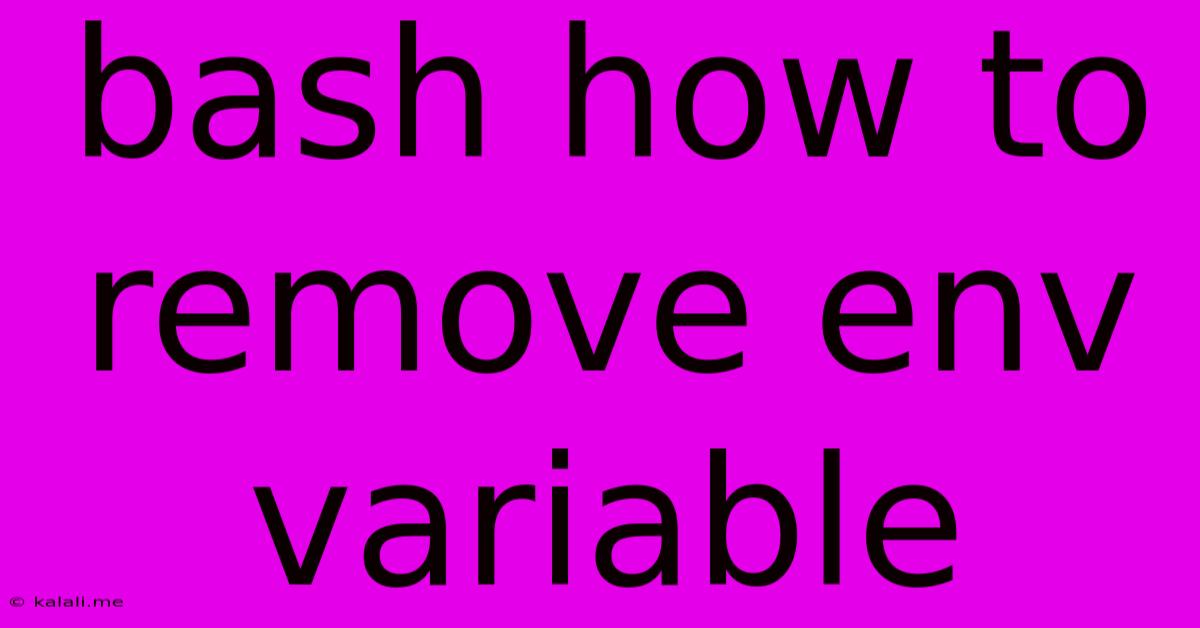Bash How To Remove Env Variable
Kalali
Jun 02, 2025 · 3 min read

Table of Contents
Bash: How to Remove Environment Variables
Removing environment variables in Bash is a crucial task for managing your shell environment effectively. Whether you're troubleshooting conflicts, cleaning up after a script, or simply streamlining your setup, knowing how to remove these variables is essential. This guide covers several methods for removing environment variables, from temporary removal within a script to permanent removal from your shell configuration. This will help you manage your environment variables and ensure a cleaner, more efficient Bash experience.
Understanding Environment Variables
Before diving into removal methods, let's briefly recap what environment variables are. These variables store information about your system's environment, such as your home directory ($HOME), the current path ($PATH), or custom settings you've defined. They influence how applications and scripts behave. Understanding their lifecycle – how and where they are set and unset – is key to managing them effectively.
Methods for Removing Environment Variables
There are several ways to remove environment variables in Bash, each suitable for different situations:
1. Using unset
The most common and straightforward method is using the unset command. This command permanently removes the variable from the current shell session. It's important to note that this removal is only within the current shell; restarting the shell will restore any variables set in your configuration files.
unset MY_VARIABLE
Replace MY_VARIABLE with the name of the environment variable you want to remove. To verify removal, you can echo the variable:
echo $MY_VARIABLE
If the variable has been successfully unset, this will produce no output.
2. Removing from a Script's Scope
If you only need to temporarily remove an environment variable within a script, you can use unset within the script itself. Changes made within the script will not affect the parent shell's environment variables. This is especially useful when working with variables that might interfere with other parts of your script or system.
#!/bin/bash
# ... some code ...
unset TEMP_VARIABLE # Remove TEMP_VARIABLE only within this script
# ... more code ...
3. Modifying Shell Configuration Files (Permanent Removal)
For permanent removal across sessions, you need to edit your shell configuration files. The specific file depends on your shell:
- Bash:
.bashrc,.bash_profile, or.bash_login(usually.bashrcis sourced by others) - Zsh:
.zshrc
Locate the line where you've set the environment variable (using export) and delete it. After saving the changes, either source the file using source ~/.bashrc (or the appropriate file for your shell) or open a new terminal window for the changes to take effect. This is the most impactful way to remove an environment variable permanently, ensuring it won't be loaded on subsequent shell sessions.
4. Handling Variables Set in Other Files
If the environment variable is set in a script or another configuration file that is sourced by your main configuration file, you will need to locate and remove it from that source file instead. Simply removing it from your main configuration file might not be enough, as it could be re-set on sourcing.
Best Practices for Managing Environment Variables
- Be mindful of dependencies: Before removing a variable, consider if other scripts or processes rely on it. Removing a critical variable might break functionality.
- Use descriptive names: Choose clear and descriptive names for your variables to avoid confusion.
- Document your environment: Keep a record of your environment variables and their purposes. This is crucial for maintainability and troubleshooting.
- Regular cleanup: Periodically review your environment variables and remove any unnecessary ones to keep your environment clean and efficient.
By understanding these methods and best practices, you can effectively manage environment variables in your Bash environment, improving your workflow and ensuring a stable and predictable shell experience. Remember to always test your changes carefully to avoid unintended consequences.
Latest Posts
Latest Posts
-
Does Native American Grow Facial Hair
Jun 04, 2025
-
I Need To Question Why You Did This
Jun 04, 2025
-
Can I Plug My Generator Into My Dryer Outlet
Jun 04, 2025
-
How To Keep Cats Off Your Car
Jun 04, 2025
-
How Many Watts Can A 15 Amp Breaker Handle
Jun 04, 2025
Related Post
Thank you for visiting our website which covers about Bash How To Remove Env Variable . We hope the information provided has been useful to you. Feel free to contact us if you have any questions or need further assistance. See you next time and don't miss to bookmark.